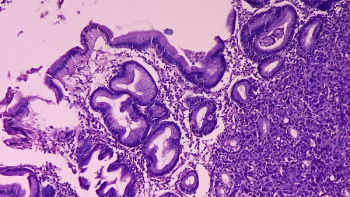
New ASCO guidelines recommend trilaciclib for patients with untreated or previously treated extensive-stage small cell lung cancer who are receiving chemotherapy or chemoimmunotherapy.

New ASCO guidelines recommend trilaciclib for patients with untreated or previously treated extensive-stage small cell lung cancer who are receiving chemotherapy or chemoimmunotherapy.

The 3-year progression-free survival rate was 94% and the 3-year overall survival rate was 97%.

The median progression-free survival with cabozantinib was 8.3 months vs 3.2 months with placebo among patients with extra-pancreatic neuroendocrine tumors.

Patients who received amivantamab plus lazertinib and chemotherapy achieved a median progression-free survival of 8.3 months.

Fixed-duration venetoclax plus rituximab continued to outperform bendamustine plus rituximab in the phase 3 MURANO trial.

Patients who received pomalidomide, bortezomib, and dexamethasone achieved a median overall survival of 35.6 months compared with 31.6 months among patients treated with bortezomib and dexamethasone.

Patients with EGFR-mutated non–small cell lung cancer had a median event-free survival of 30.8 months in the durvalumab arm and 19.6 months in the placebo arm.

The pathological complete response among patients who received durvalumab plus chemotherapy was 17.2% vs 4.3% in the placebo plus chemotherapy arm.

Patrimumab deruxtecan garnered a 29.8% overall response rate in pretreated patients with EGFR-mutated non–small cell lung cancer.

The rate of minimal residual disease-negative complete remission was 34.4% with ponatinib vs 16.7% with imatinib.

Patients with high-risk classical Hodgkin lymphoma who experience a slow early response to frontline chemotherapy may benefit from the addition of pembrolizumab to COPDAC-28 consolidation.

Subcutaneous trastuzumab demonstrated a safety profile that is consistent with the known profile with intravenous administration.

The median progression-free survival among patients in the intention-to-treat population who received niraparib was 24.8 months compared with 8.3 months among patients who received placebo.

The median disease-free survival with GVAX vaccine plus low-dose cyclophosphamide; GVAX plus cyclophosphamide and nivolumab; and GVAX plus cyclophosphamide, nivolumab, and urelumab, was 13.90 months, 26.1 months, and 31.6 months, respectively.

Patients with relapsed/refractory primary mediastinal large B-cell lymphoma achieved antitumor responses with pembrolizumab.

Relacorilant in combination with nab-paclitaxel did not meet the statistical significance threshold for progression-free survival vs nab-paclitaxel alone.

Patients with colorectal cancer or non–small cell lung cancer who were treated in the outpatient setting and were not admitted 30 days prior to diagnosis experienced a statistically significant increase in delay of time to treatment initiation.

At a follow-up of 6.1 years, patients who received regional nodal irradiation did not achieve significant reductions in locoregional recurrence rates compared to those who received surgery alone.

Lazertinib reduced the risk of progression by 55% in patients with EGFR-mutated advanced non–small cell lung cancer compared with gefitinib.

Trastuzumab deruxtecan elicited a confirmed objective response rate of 42% in patients with HER2-positive gastric or gastroesophageal junction cancer, according to findings from the phase 2 DESTINY-Gastric02 trial.

The onset of skeletal events and events that affect health-related quality of life were delayed with the addition of lutetium Lu 177 vipivotide tetraxetan to standard of care for patients with metastatic castration-resistant prostate cancer.

The National Comprehensive Cancer Network has updated their guidelines on high-dose methotrexate and glucarpidase.

Adverse experiences, such as smoking and experiencing physical abuse, do not necessarily decrease the frequency of colorectal cancer screenings.

Novel strategies for patient education can help to build trust in and decrease the fear of lung cancer screening among patients.

In the phase 2 DESTINY-PanTumor02 trial, trastuzumab deruxtecan elicited clinical activity across a range of HER2 expressing solid tumors.

Patients with advanced-stage Hodgkin lymphoma who received nivolumab plus AVD experienced a 1-year estimated progression-free survival rate of 94% meeting the primary end point of the phase 3 SWOG S1826 trial.

Treatment with imetelstat elicited statistically significant and clinically meaningful improvements in transfusion independence among patients with lower-risk myelodysplastic syndrome.

Statistically and clinically meaningful improvements in invasive disease-free survival were observed among patients with hormone receptor–positive/HER2-negative early breast cancer who received ribociclib in addition to endocrine therapy.

Treatment with encorafenib in combination with cetuximab and binimetinib was active with a manageable safety profile in the first-line setting for patients with BRAF V600E–mutated metastatic colorectal cancer.

The US Preventive Services Task Force is working on a draft recommendation which would lower the age of breast cancer screenings from 50 years to 40 years for women at average risk.